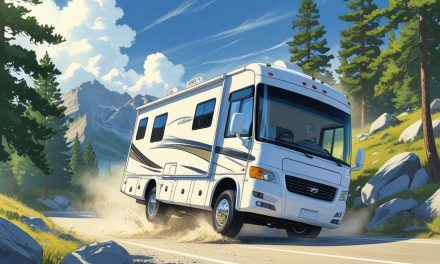Would you like to save this article?
If you’re thinking about hitting the road full-time in your dream RV, you might want to sit down for this one. Financing an RV as a full-timer isn’t like buying your weekend camping trailer – it’s a whole different ballgame that can catch even the most prepared adventurers off guard.
Chris and Megan from “Why Wait” learned this lesson the hard way when they tried to finance their second RV. After successfully financing their first Grand Design Solitude six years ago with no problems, they hit a brick wall when trying to upgrade. What changed? They had become full-time RVers – and that simple fact turned their financing dreams into a bureaucratic nightmare.
The RV financing market is booming, with over $15.5 billion in wholesale loans in 2024 according to the Recreation Vehicle Industry Association (RVIA). But here’s what the industry doesn’t advertise: full-time RVers face unique challenges that can make getting approved feel impossible, even with excellent credit and steady income.
1. Your Address is Your Achilles’ Heel
The Problem: Banks don’t trust nomads. When you use an Escapees mail forwarding service address or any address that shows up as a campground, red flags immediately pop up in the lender’s system.
Why It Matters: Lenders want collateral they can find and repossess. No permanent address = no way to track you down if you default. Your Escapees address will show up as being located in a campground, instantly outing you as a full-timer.
The Stats: According to industry data, traditional banks reject approximately 70% of full-time RVer applications due to address verification issues.
| Address Type | Approval Rate | Risk Level |
|---|---|---|
| Traditional Home | 85-90% | Low |
| Family Member’s Address | 75-80% | Medium |
| Escapees/Mail Service | 15-25% | High |
| RV Park Lot Ownership | 30-40% | High |
You’d think owning property would help, right? Wrong. Chris and Megan owned a deeded lot in an RV resort, but the banks still said no because it was associated with a campground. Property ownership doesn’t matter if it’s in the wrong location.
2. The “Sticks and Bricks” Catch-22
The Golden Rule: Finance your RV before you sell your house, not after.
Why This Backfires: Most people need the money from selling their home to buy the RV – but once you sell, you lose your qualifying address. It’s a classic catch-22 that traps aspiring full-timers.
Real Talk: If you’re planning to sell your house to fund your RV purchase, you’re probably better off buying the RV outright rather than trying to finance after the sale. The financing hoops become nearly impossible to jump through.
Pro Tip: Use a family member’s address on your driver’s license before you go full-time. This gives you a backup qualifying address for future financing needs.
3. Motor Homes Are the “Luxury Item” Nobody Wants to Finance
The Hard Truth: Motor homes are considered luxury items by lenders, making them much harder to finance than travel trailers or fifth wheels.
Interest Rate Reality Check:
- Traditional RV buyers: 4-8% interest rates
- Full-time RVers: 8-15% interest rates
- Motor homes for full-timers: 12-18% interest rates
The Average Financing Data (2024):
- Average down payment: 18.5%
- Average amount financed: $61,891
- Average loan term: 15-20 years
As Chris puts it: “I’m never going to own this motor home. The way I look at it is I’m just renting it – this is the price I’m paying to rent this while I own it until we sell it and get a new one.”
4. The LLC Loophole (And Why It’s Not Always the Answer)
The Montana LLC Strategy: Some full-timers finance through an LLC to avoid sales tax and address issues. The LLC owns the RV, not you personally.
How It Works:
- Set up an LLC in Montana
- Use the LLC’s address for financing
- Avoid personal address verification issues
- Sometimes avoid state sales tax
The Downsides:
- More complex paperwork
- Additional legal and tax implications
- Not all lenders accept LLC financing
- May complicate insurance
Chris and Megan had an LLC ready to go but found a better solution through specialized lenders.
5. The Secret Lenders That Actually Want Your Business
Game Changer: There are specialized lenders who actually understand and work with full-time RVers.
The Companies That Get It:
- Alliant Credit Union (Chris and Megan’s choice)
- Into RV (financing specialists)
- National Vehicle (full-timer friendly)
What Makes Them Different:
- They expect full-time RVers
- No address discrimination
- Understand the lifestyle
- Streamlined processes for nomads
The Trade-Off: You’ll pay higher interest rates, but you’ll actually get approved. Sometimes paying 3-4% more is worth it compared to getting rejected everywhere else.
6. The Documentation Avalanche
Be Prepared For: Full-time RV financing requires significantly more documentation than traditional loans.
What You’ll Need:
- 2-3 years of tax returns
- Bank statements (multiple months)
- Employment verification
- Proof of income
- Insurance documentation
- RV inspection reports
Reality Check: The process took Chris and Megan much longer than expected, with multiple rounds of document requests. Plan for 30-60 days instead of the typical 7-14 days for traditional RV loans.
Success Factors:
- Excellent credit score (720+ preferred)
- Stable employment history
- Low debt-to-income ratio
- Substantial down payment (20%+ recommended)
7. The Insurance Truth Bomb
Critical Warning: Never tell insurance companies you’re going full-time unless they specifically cover full-timers.
The Insurance Game:
- Loan companies: Don’t care about full-time status
- Insurance companies: DO care and will drop you
What This Means:
- Find full-timer friendly insurance first
- Be honest with the right companies
- Don’t volunteer information to traditional insurers
Full-Timer Insurance Options:
- National General (full-timer policies)
- Progressive (some full-timer coverage)
- Good Sam (specialized RV insurance)
The Bottom Line: Is It Worth the Hassle?
The Market Reality: The RV financing market is expected to grow from $39.58 billion in 2025 to $57.32 billion by 2030, but full-timers still face unique challenges.
Chris and Megan’s Final Word: Even with all the hassles, they made it work. The key is knowing what you’re up against and having realistic expectations about:
- Higher interest rates
- More documentation
- Longer approval times
- Specialized lenders only
Your Action Plan:
- Keep your current address as long as possible
- Research full-timer friendly lenders before you need them
- Get pre-approved before you shop
- Have all documentation ready
- Budget for higher rates
- Consider buying outright if possible
The 2024 Market Outlook: With over 200,000 retail RV loans funded in 2024 totaling $11.5 billion, the financing is out there – you just need to know where to look and what to expect.
Remember: Every challenge has a solution. Chris and Megan went from rejection to approval by finding the right lender and being prepared for the process. Your full-time RV dreams are still achievable – you just need the right roadmap to get there.
Meta Description: Discover the 7 hidden challenges full-time RVers face when financing their dream motorhome. Learn insider secrets, specialized lenders, and proven strategies to get approved despite address issues and higher rates.
SOURCES
- Why Wait YouTube Channel – RV Financing Tips
- RVIA Survey of Lenders’ Experiences 2024
- RV Business – RVIA Lenders Survey Results
- Mordor Intelligence – Recreational Vehicle Financing Market
- Web Finance Direct – RV Market Trends
- Sewell Motorcoach
- Endless RVing – RV Financing Discussion





